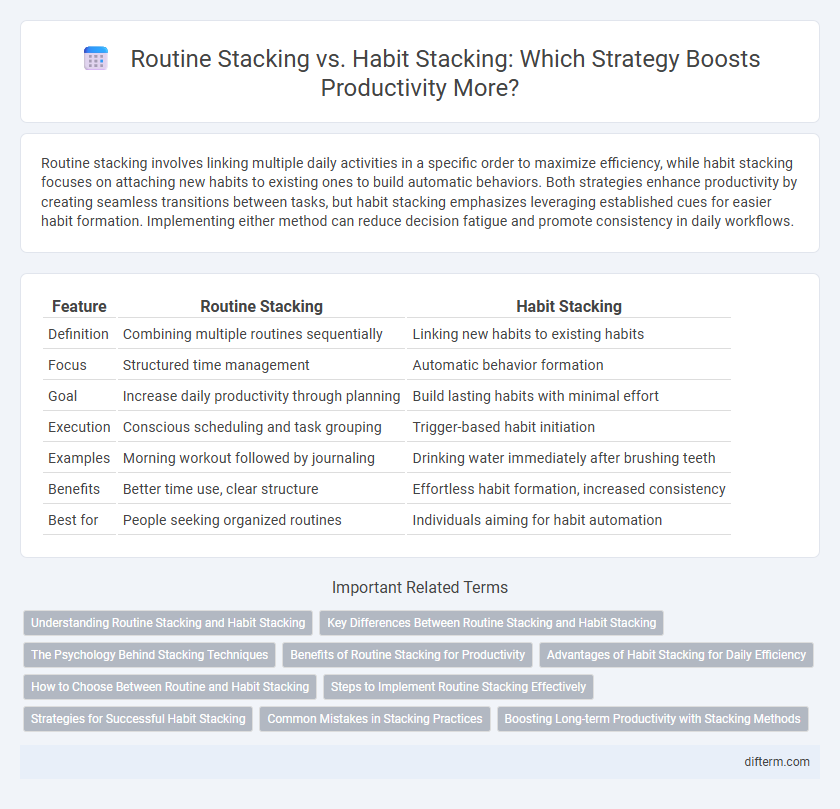Routine stacking involves linking multiple daily activities in a specific order to maximize efficiency, while habit stacking focuses on attaching new habits to existing ones to build automatic behaviors. Both strategies enhance productivity by creating seamless transitions between tasks, but habit stacking emphasizes leveraging established cues for easier habit formation. Implementing either method can reduce decision fatigue and promote consistency in daily workflows.
Table of Comparison
| Feature | Routine Stacking | Habit Stacking |
|---|---|---|
| Definition | Combining multiple routines sequentially | Linking new habits to existing habits |
| Focus | Structured time management | Automatic behavior formation |
| Goal | Increase daily productivity through planning | Build lasting habits with minimal effort |
| Execution | Conscious scheduling and task grouping | Trigger-based habit initiation |
| Examples | Morning workout followed by journaling | Drinking water immediately after brushing teeth |
| Benefits | Better time use, clear structure | Effortless habit formation, increased consistency |
| Best for | People seeking organized routines | Individuals aiming for habit automation |
Understanding Routine Stacking and Habit Stacking
Routine stacking involves linking several related tasks into a single, streamlined sequence to enhance daily productivity, while habit stacking pairs new habits with existing ones to build lasting behavioral changes. Routine stacking optimizes workflows by organizing activities based on their natural order and context, creating seamless efficiency. Habit stacking leverages the automaticity of established routines, making it easier to adopt and maintain new productive behaviors over time.
Key Differences Between Routine Stacking and Habit Stacking
Routine stacking involves organizing multiple related tasks into a single workflow to boost overall efficiency, while habit stacking links a new habit directly to an existing one to create seamless behavioral triggers. Routine stacking focuses on task sequences and time management, whereas habit stacking emphasizes behavioral reinforcement and automaticity. Understanding these key differences helps enhance productivity by strategically combining actions versus embedding new habits within established routines.
The Psychology Behind Stacking Techniques
Routine stacking leverages established daily patterns by linking new tasks to existing sequences, enhancing task completion through contextual cues. Habit stacking builds behaviors by attaching new habits to already ingrained actions, exploiting associative learning and cue-response mechanisms in the brain. Both techniques tap into the brain's reliance on automaticity and environmental triggers to increase productivity and reduce cognitive load.
Benefits of Routine Stacking for Productivity
Routine stacking enhances productivity by organizing multiple related tasks into a seamless flow, reducing decision fatigue and time wastage. This method leverages existing habits to build efficient daily workflows, enabling consistent achievement of goals. By integrating routines, individuals create structured environments that foster momentum and sustained focus throughout the day.
Advantages of Habit Stacking for Daily Efficiency
Habit stacking enhances daily efficiency by seamlessly linking new behaviors to established routines, reducing cognitive load and increasing consistency. This method leverages the brain's pattern recognition, promoting automaticity and minimizing decision fatigue. Integrating small, purposeful habits into existing ones streamlines productivity and fosters sustained behavioral change over time.
How to Choose Between Routine and Habit Stacking
Choosing between routine stacking and habit stacking depends on the complexity and goals of your productivity system. Routine stacking organizes a sequence of related tasks to streamline workflow and improve efficiency, while habit stacking pairs new habits with existing behaviors to reinforce positive changes effortlessly. Evaluate your daily patterns and productivity objectives to determine whether building structured routines or embedding small, consistent habits will better enhance your focus and output.
Steps to Implement Routine Stacking Effectively
Routine stacking involves linking complete routines back-to-back to form a seamless daily flow, whereas habit stacking attaches a new habit to an existing one. To implement routine stacking effectively, identify complementary routines such as morning exercise followed by meditation, then schedule them consecutively to maintain momentum. Consistently track progress using apps or journals to ensure the routines blend smoothly and optimize overall productivity.
Strategies for Successful Habit Stacking
Routine stacking involves linking several tasks in a fixed sequence, while habit stacking pairs a new habit with an existing one to reinforce behavior. Successful habit stacking strategies include choosing strong anchor habits, limiting new additions to one at a time, and ensuring each habit is specific and actionable. Leveraging environmental cues and tracking progress enhances consistency and long-term habit formation.
Common Mistakes in Stacking Practices
Common mistakes in routine stacking include overloading schedules with too many tasks, leading to burnout and reduced efficiency. Habit stacking errors often involve pairing unrelated or incompatible habits, which disrupts consistency and weakens formation. Neglecting to align new habits with existing routines can reduce the effectiveness of both stacking methods in productivity improvement.
Boosting Long-term Productivity with Stacking Methods
Routine stacking involves organizing daily activities in a fixed sequence to create consistent productivity patterns, while habit stacking links new habits to existing ones, enhancing behavioral efficiency. Both methods leverage cognitive triggers to streamline task completion and minimize decision fatigue, significantly boosting long-term productivity by reinforcing positive workflows. Integrating routine and habit stacking fosters sustainable momentum, resulting in improved focus, time management, and goal achievement.
Routine stacking vs habit stacking Infographic

 difterm.com
difterm.com